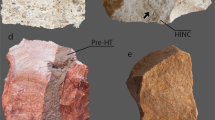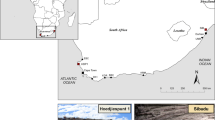Abstract
When heat treatment of silcrete for stone knapping was first discovered in the South African Middle Stone Age (MSA), the procedure used for it was suggested to be similar to the one used for heat treatment of finer rocks in other parts of the world: slow sand-bath heating. This comparison may have been based on published data from the fields of ethnography, experimentation and archaeology, describing sand-bath like structures and processes. In this review, I discuss whether the available data from these three fields indeed justify the suggestions that sand-bath heating was used in the context of MSA silcrete heat treatment. A careful revaluation of the available data shows that, although sand-bath heating is a widely accepted procedure that is documented in other parts of the world, understanding the earliest known cases of heat treatment in the MSA calls for another technical procedure.
Résumé
Lors de la découverte du traitement thermique réalisé sur les silcrètes du Middle Stone Age (MSA) d’Afrique du Sud, l’hypothèse d’un traitement en bain de sable, processus largement utilisé pour la chauffe des silex dans d’autres régions du monde, a été proposée. Cette assimilation repose sur des données issues des recherches en ethnographie, archéologie ou sur des travaux expérimentaux utilisant des structures similaires à des bains de sable. Cet article considère les données publiées dans ces trois domaines et tente d’évaluer si la chauffe en bain de sable a réellement pu être utilisée dans le contexte du MSA d’Afrique du Sud. Les résultats de cette réévaluation montrent que, même si la chauffe en bain de sable est bien documentée et largement acceptée comme une technique répandue dans le monde scientifique, la compréhension des premiers traitements thermiques dans le MSA d’Afrique du Sud doit faire appel à une autre technique de chauffe.

Similar content being viewed by others
References
Akerman, K. (1979). Heat and lithic technology in the Kimberleys, W. A. Archaeology & Physical Anthropology in Oceania, 14, 144–151.
Anderson, D. C. (1978). Aboriginal use of Tongue River silica in northwest Iowa. The Plains Anthropologist, 23, 149–157.
Arthur, K. W. (2010). Feminine knowledge and skill reconsidered: Women and flaked stone tools. American Anthropologist, 112, 228–243.
Bentsen, S. E. (2013). Controlling the heat: An experimental approach to Middle Stone Age pyrotechnology. South African Archaeological Bulletin, 68, 137–145.
Bordes, F. (1969). Traitement thermique du silex au Solutréen. Bulletin de la Société Préhistorique Française, 66, 197.
Brown, K., & Marean, C. (2010). Wood fuel availability for heat treatment drives the rise and fall of silcrete as a raw material in the Middle Stone Age of South Africa, Abstracts of the PaleoAnthropology Society 2010 Meetings. PaleoAnthropology, 2010, A0001–A0040.
Brown, K. S., Marean, C. W., Herries, A. I. R., Jacobs, Z., Tribolo, C., Braun, D., Roberts, D. L., Meyer, M. C., & Bernatchez, J. (2009). Fire as an engineering tool of early modern humans. Science, 325, 859–862.
Burnham, C., Holloway, J., & Davis, N. (1969). Thermodynamic properties of water to 1,000°C and 10,000 bars. Geological Society of America Special Papers, 132, 1–96.
Clark, J. D., & Khana, G. S. (1989). The site of Khunjhun II, middle Son Valley, and its relevance for the Neolithic of Central India. In J. M. Kenoyer (Ed.), Old problems and new perspectives in the archaeology of South Asia (pp. 29–46). Madison: University of Michigan.
Eriksen, B. V. (1997). Implications of thermal pre-treatment of chert in the German Mesolithic. In R. Schild & Z. Sulgostowska (Eds.), Man and flint, Proceedings of the VII International Flint Symposium, Warszawa-Ostrowiec Swietokrzyski, September 1995 (pp. 325–329). Warsaw: Institute of Archaeology and Ethnology Polish Academy of Sciences.
Flörke, O. W., Köhler-Herbertz, B., Langer, K., & Tönges, I. (1982). Water in microcrystalline quartz of volcanic origin: Agates. Contributions to Mineralogy and Petrology, 80, 324–333.
Fukuda, J., Peach, C. J., Spiers, C. J., & Nakashima, S. (2009). Electrical impedance measurement of hydrous microcrystalline quartz. Journal of Mineralogical and Petrological Sciences, 104, 176–181.
Goldschmidt, W. (1951). Nomlaki ethnography. Berkeley: University of California Press.
Graetsch, H., Flörke, O. W., & Miehe, G. (1985). The nature of water in chalcedony and opal-C from Brazilian agate geodes. Physics and Chemistry of Minerals, 12, 300–306.
Griffiths, D. R., Bergman, C. A., Clayton, C. J., Ohnuma, K., & Robins, G. V. (1987). Experimental investigation of the heat treatment of flint. In G. de G. Sieveking & M. H. Newcomer (Eds.), The human uses of flint and chert (pp. 43–52). Proceedings of the Fourth International Flint Symposium held at Brighton Polytechnic, 10–15 April 1983. Cambridge: Cambridge University Press.
Grinnell, G. B. (1895). The story of the Indian. New York: D. Appleton.
Hester, T. R. (1972). Ethnographic evidence for the thermal alteration of siliceous stone. Tebiwa, 15, 63–65.
Inizan, M. L., & Tixier, J. (2001). L’émergence des arts du feu: Le traitement thermique des roches siliceuses. Paléorient, 26, 23–36.
Kenoyer, J. M., Vidale, M., & Bhan, K. K. (1991). Contemporary stone bead making in Khambhat, India: Patterns of craft specialisation and organisation of production as reflected in the archaeological record. World Archaeology, 23, 45–63.
Mandeville, M. D. (1973). A consideration of the thermal pretreatment of chert. Plains Anthropologist, 18, 177–202.
Mandeville, M. D., & Flenniken, J. (1974). A comparison of the flaking qualities of Nehawka chert before and after thermal pretreatment. Plains Anthropologist, 19, 146–148.
Mercieca, A. (2000). An experimental study of heat fracturing in silcrete. Australian Archaeology, 51, 40–47.
Mercieca, A., & Hiscock, P. (2008). Experimental insights into alternative strategies of lithic heat treatment. Journal of Archaeological Science, 35, 2634–2639.
Mourre, V., Villa, P., & Henshilwood, C. S. (2010). Early use of pressure flaking on lithic artifacts at Blombos Cave, South Africa. Science, 330, 659–662.
Patterson, L. W. (1995). Thermal damage of chert. Lithic Technology, 20, 72–80.
Porraz, G., Texier, P.-J., Archer, W., Piboule, M., Rigaud, J.-P., & Tribolo, C. (2013). Technological successions in the Middle Stone Age sequence of Diepkloof Rock Shelter, Western Cape, South Africa. Journal of Archaeological Science, 40, 3376–3400.
Powell, J. W. (1874). Report of the explorations in 1873 of the Colorado of the West and its tributaries. Washington: Govt. print. off.
Schmidt, P. (2014). What causes failure (overheating) during lithic heat treatment? Archaeological and Anthropololgical Sciences, 6, 107–112.
Schmidt, P., Badou, A., & Fröhlich, F. (2011). Detailed FT near-infrared study of the behaviour of water and hydroxyl in sedimentary length-fast chalcedony, SiO2, upon heat treatment. Spectrochimica Acta Part A: Molecular and Biomolecular Spectroscopy, 81, 552–559.
Schmidt, P., Masse, S., Laurent, G., Slodczyk, A., Le Bourhis, E., & Perrenoud, C. (2012). Crystallographic and structural transformations of sedimentary chalcedony in flint upon heat treatment. Journal of Archaeological Science, 39, 135–144.
Schmidt, P., Porraz, G., Slodczyk, A., Bellot-Gurlet, L., Archer, W., & Miller, C. E. (2013). Heat treatment in the South African Middle Stone Age: Temperature induced transformations of silcrete and their technological implications. Journal of Archaeological Science, 40, 3519–3531.
Schmidt, P., Paris, C., & Bellot-Gurlet, L. (2015a). The investment in time needed for heat treatment of flint and chert. Archaeological and Anthropological Sciences. doi:10.1007/s12520-015-0259-y.
Schmidt, P., Porraz, G., Bellot-Gurlet, L., February, E., Ligouis, B., & Paris, C. (2015b). A previously undescribed organic residue sheds light on heat treatment in the Middle Stone Age. Journal of Human Evolution, 85, 22–34.
Schumacher, P. (1877). Methods of making stone weapons. US Geographical and Geological Survey Bulletin, 3, 547–549.
Shippee, J. M. (1963). Was flint annealed before flaking? Plains Anthropologist, 8, 271–272.
Voegelin, E. W. (1938). Tübatulabal ethnography. Berkeley: University of California Press.
Wadley, L. (2013). Recognizing complex cognition through innovative technology in Stone Age and Palaeolithic sites. Cambridge Archaeological Journal, 23, 163–183.
Wadley, L., & Prinsloo, L. C. (2014). Experimental heat treatment of silcrete implies analogical reasoning in the Middle Stone Age. Journal of Human Evolution, 70, 49–60.
Wilke, P. J., Flenniken, J., & Ozbun, T. L. (1991). Clovis technology at the Anzick site, Montana. Journal of California and Great Basin Anthropology, 13, 242–272.
Acknowledgments
I thank the Deutsche Forschungsgemeinschaft (DFG) for funding my research project Heat Treatment in the South African MSA that made the present paper possible.
Author information
Authors and Affiliations
Corresponding author
Ethics declarations
Funding
This study was funded by the Forschungsgemeinschaft (DFG) (Grant Nr: CO 226/25-1, MI 1748/2-1, NI 299/25-1).
Conflict of Interest
The author declares that he has no conflict of interest.
Rights and permissions
About this article
Cite this article
Schmidt, P. The ‘Sand-Bath’ and Lithic Heat Treatment in the South African Middle Stone Age: Myth or Reality?. Afr Archaeol Rev 33, 99–105 (2016). https://doi.org/10.1007/s10437-016-9217-z
Published:
Issue Date:
DOI: https://doi.org/10.1007/s10437-016-9217-z




